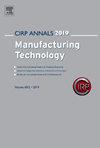双面抛光中工件旋转行为的动力学分析
IF 3.6
3区 工程技术
Q2 ENGINEERING, INDUSTRIAL
引用次数: 0
摘要
双面抛光(DSP)采用独特的夹紧机构,实现工件的自由旋转,这是实现均匀材料去除的关键。然而,DSP工艺长期以来一直面临着工件不旋转导致形状变细的问题,这一问题与硅片抛光特别相关。在本研究中,进行了动力学分析,以研究DSP过程中的工件旋转,并阐明了锥化的机制。该分析确定了控制转速的关键变量和导致工件不旋转的主要因素。这些发现在实验中得到了验证,并提出了一种实用的防止变细的方法。本文章由计算机程序翻译,如有差异,请以英文原文为准。
Kinetic analysis of workpiece rotation behavior during double-sided polishing
Unique clamping mechanism adopted in double-sided polishing (DSP) enables free rotation of workpieces, which is critical for achieving uniform material removal. However, the DSP process has long faced the issue of non-rotating workpieces, resulting in tapered shapes—an issue particularly relevant to silicon wafer polishing. In this study, a kinetic analysis is conducted to investigate workpiece rotation during DSP and to clarify the mechanism underlying tapering. This analysis identifies key variables governing rotational speed and primary factors contributing to workpiece nonrotation. These findings are validated experimentally, and a practical approach to preventing tapering is proposed.
求助全文
通过发布文献求助,成功后即可免费获取论文全文。
去求助
来源期刊

Cirp Annals-Manufacturing Technology
工程技术-工程:工业
CiteScore
7.50
自引率
9.80%
发文量
137
审稿时长
13.5 months
期刊介绍:
CIRP, The International Academy for Production Engineering, was founded in 1951 to promote, by scientific research, the development of all aspects of manufacturing technology covering the optimization, control and management of processes, machines and systems.
This biannual ISI cited journal contains approximately 140 refereed technical and keynote papers. Subject areas covered include:
Assembly, Cutting, Design, Electro-Physical and Chemical Processes, Forming, Abrasive processes, Surfaces, Machines, Production Systems and Organizations, Precision Engineering and Metrology, Life-Cycle Engineering, Microsystems Technology (MST), Nanotechnology.
 求助内容:
求助内容: 应助结果提醒方式:
应助结果提醒方式:


